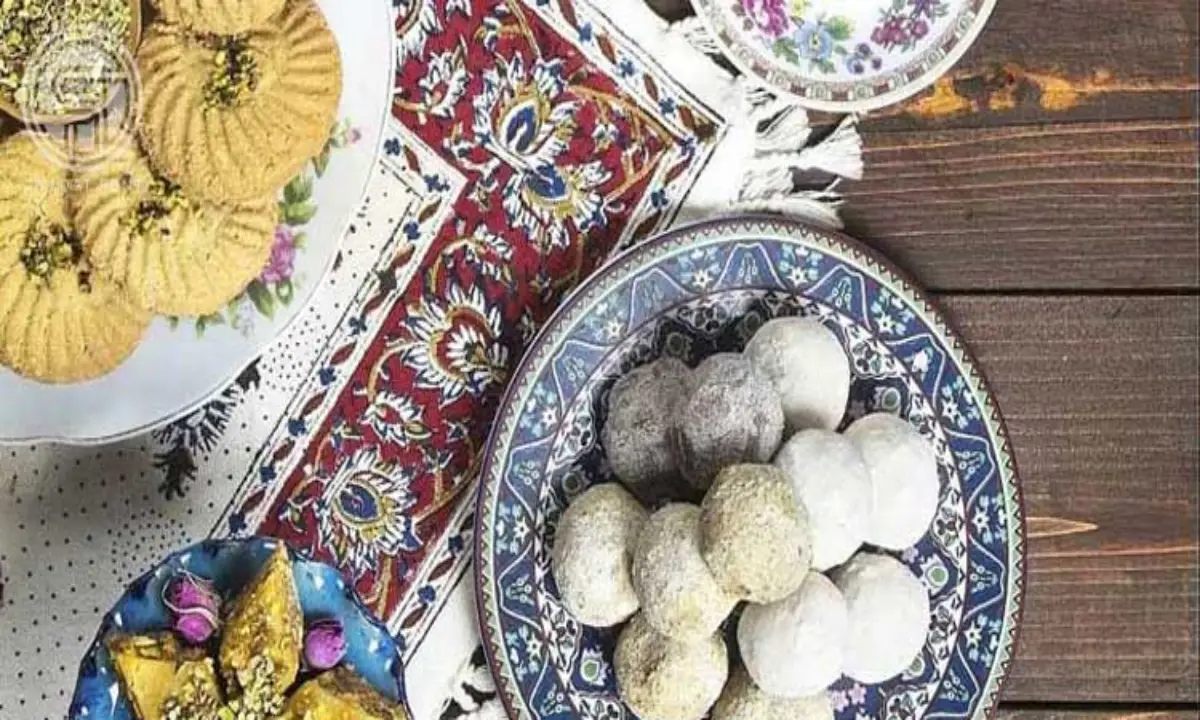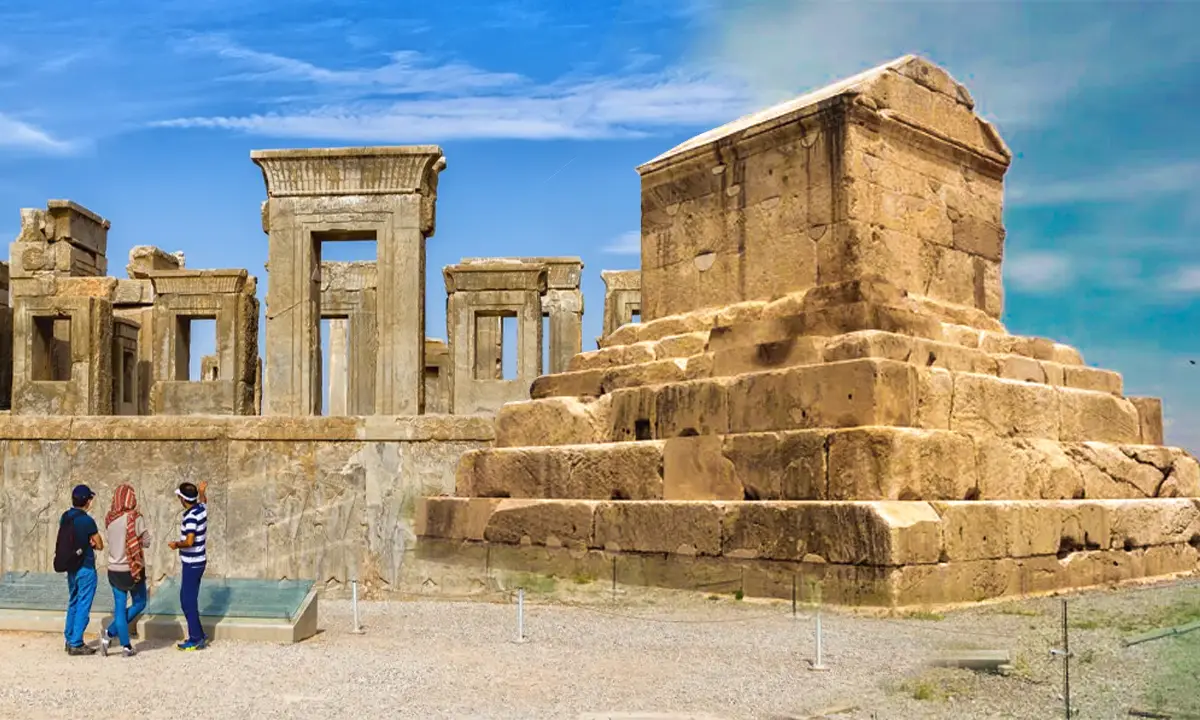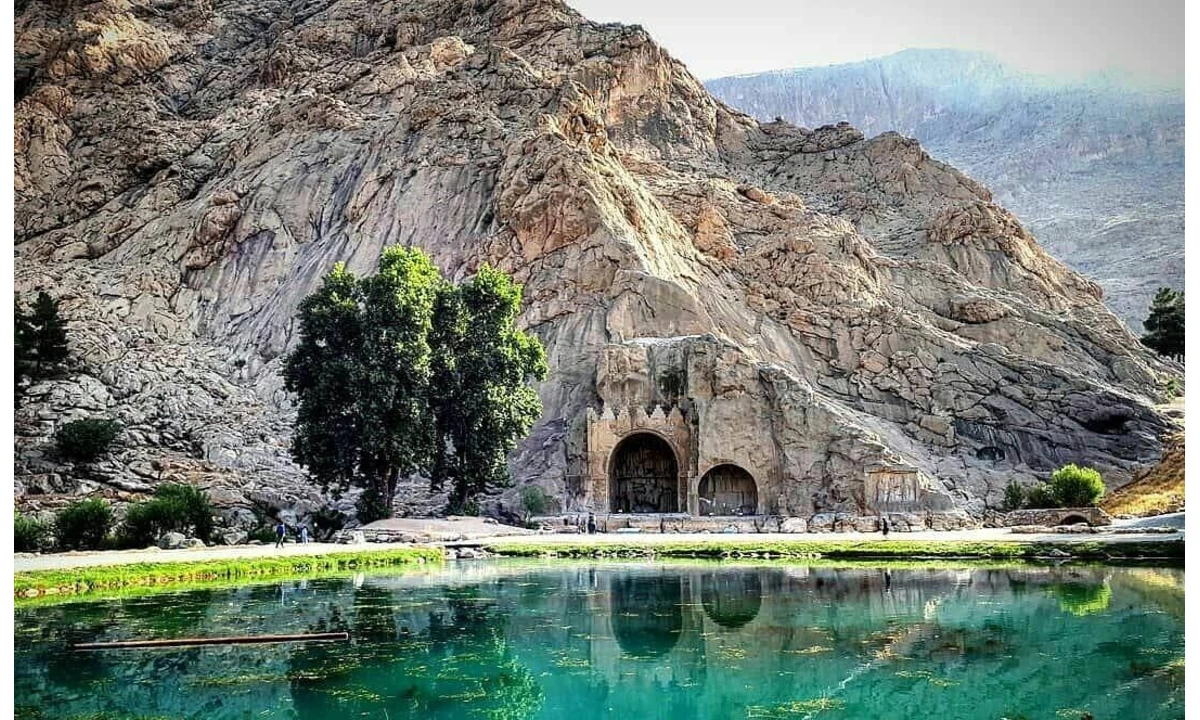Sheikh Safi al-Din Khānegāh and Shrine Ensemble
![]() Author : shiva | Date : Tuesday 05 August 2025 09:37
Author : shiva | Date : Tuesday 05 August 2025 09:37
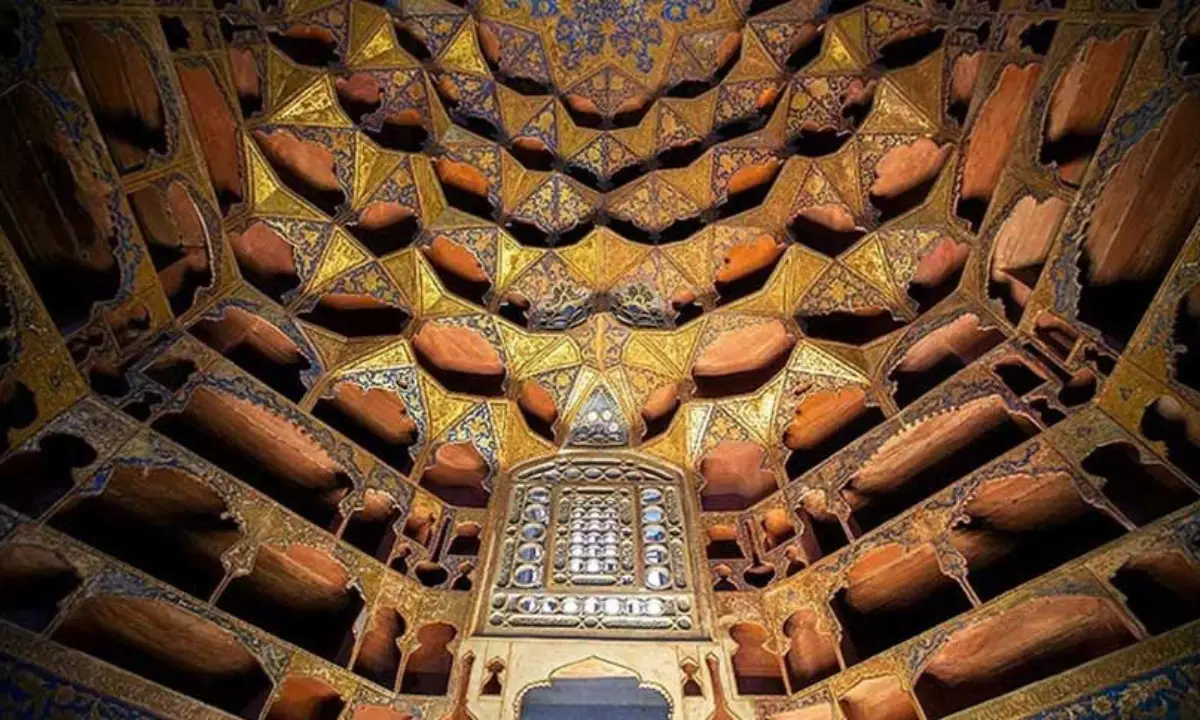
Get acquainted with the masterpiece of Iranian architecture
Sheikh Safi al-Din Khānegāh and the Shrine Ensemble are one of the most important places in Iranian tourism and a prominent place in Iran, located in the Ali Qapu neighborhood of Ardebil. It is a masterpiece of its kind, unmatched in terms of repentance and breadth.
Sheikh Safi Al-Din Ardabili's Shrine was built from the early 16th AH century until the late 18th AH century. This valuable and historic place was registered on the UNESCO World Heritage List in 2010.
This place is made using traditional Iranian architecture and the maximum amount of available space, and there are various types of parts such as a library, mosque, school, reservoir, hospital, kitchen, bakery, and several office buildings.
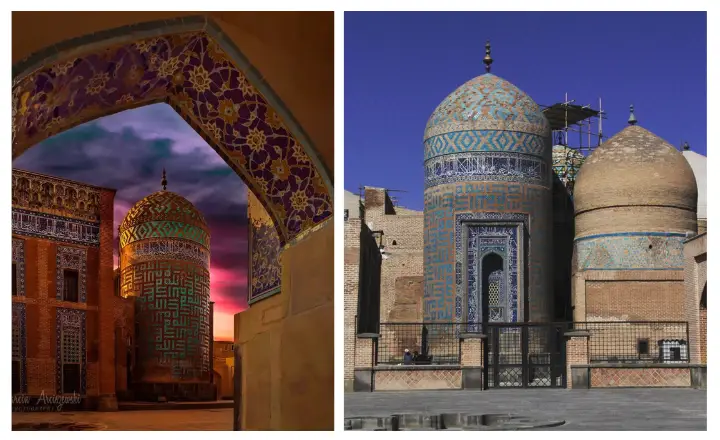
Sheikh Safi al-Din Khānegāh and the Shrine Ensemble are some of the most valuable places in Ardebil, the largest, most complete, and most prominent in the country. This tomb has a high value in terms of artistic and architectural masterpieces and the presentation of basic mystical principles throughout the world. The Ilkhani and Timurid architecture, inspired by Sufi philosophy, created new types of spaces and decorative patterns.
This collection, which is the tomb of the founder of the Safavid Dynasty, Ismail I, has kept its sanctity and value to this day. There are many Iran tours available for tourists to make a comfortable and planned trip to this place, and you can join them too. But if you want to know more about this place and also want to know who Sheikh Safi al-din was, stay with us.
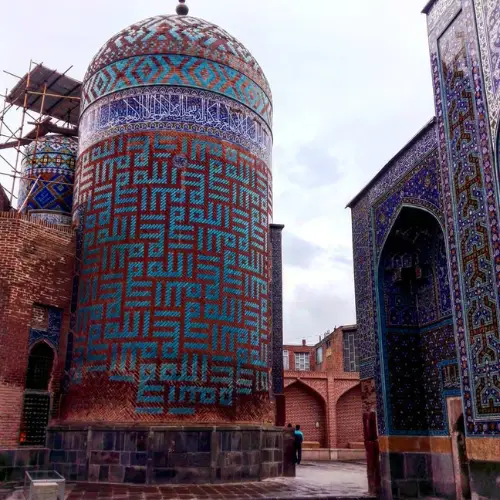
Visitor's Guide to Sheikh Safi Al-Din Ardabili's Shrine
Embark on a journey to the heart of Ardabil, Iran, and explore the spiritual legacy of Safi-ad-Din Ardabili at Sheikh Safi Al-Din Ardabili's Shrine. This quick guide ensures you won't miss the essential details for a memorable visit.
Visiting Hours of Sheikh Safi Al-Din Ardabili's Shrine
- Spring/Summer: 9 AM - 7 PM
- Fall/Winter: 9 AM - 5 PM
Entry Fees
- General Admission: $1 (subject to change)
Highlights
- Witness the architectural splendor and spiritual ambiance that encapsulates the essence of Safi-ad-Din Ardabili.
- Explore the intricate mosaic tiles, majestic domes, and sacred spaces where the legacy of Sheikh Safi Al-Din Ardabili continues to inspire.
Visitor Tips
- Dress Appropriately: Ensure to dress modestly in respect of the shrine's spiritual significance.
- Photography: Allowed outside the main tomb area. Please respect the sanctity of the site.
Discover the rich history and serene beauty of Sheikh Safi Al-Din Ardabili's Shrine, a testament to the enduring legacy of Safi-ad-Din Ardabili.
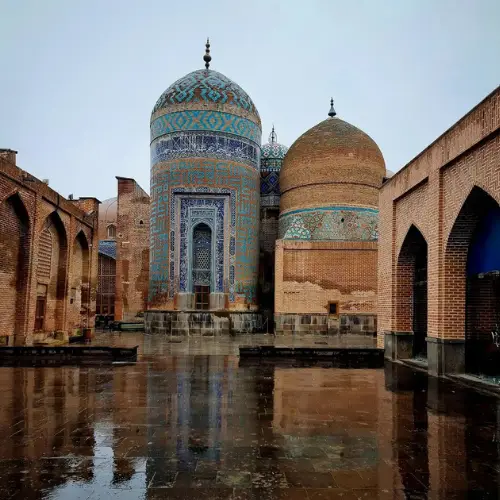
Nearby Attractions of Sheikh Safi Al-Din Ardabili's Shrine
| Highlights | Distance from Shrine | Attraction |
|---|---|---|
| Traditional crafts and spices | 2 km | Ardabil Bazaar |
| Natural beauty, boating | 5 km | Shorabil Lake |
| Hiking, hot springs | 25 km | Sabalan Mountain |
Sheikh Safi Al-Din Ardabili's Shrine Ensemble architecture
The unique feature of Sheikh Safi al-Din Khānegāh and the Shrine Ensemble is the combination of beautiful works of art in various fields, including the finest types of mosaic tiles, Mogharnas, and plaster, beautiful inscriptions, and the great Safavid calligraphy (Mir Emad, Mir Qavameddin, Mohammad Ismail, and other professors), valuable monabbats, silverware, works with gold, and paintings, all of which are in a unique architectural structure. The collection of these works has created a splendid splendor for Sheikh Safi al-Din Khānegāh and the Shrine Ensemble.
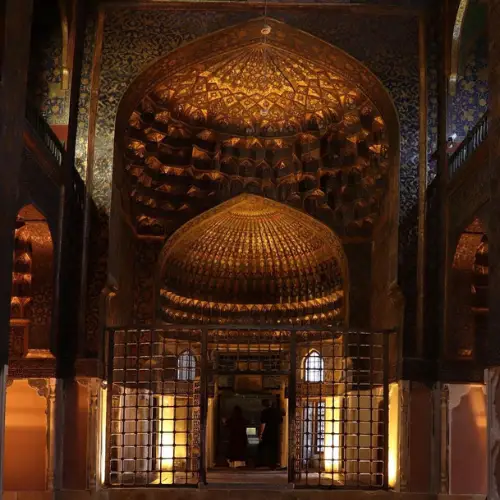 \
\
Sheikh Safi Al-Din Ardabili's Shrine Ensemble were constructed over time, and several graves were added to them. During the reign of Shah Abbas I, extensive works were undertaken to finish and embellish Sheikh Safi al-Din Khnegh and the Shrine Ensemble, owing to his devotion to Sheikh Safi al-Din and frequent visits to his tomb for pilgrimage.
In the Safavid era, Sheikh Safi al-Din Khānegāh and the Shrine Ensemble were decorated with the presence of the great masters of the Safavid era, which is still considered to be one of the historic and culturally honored attractions of Iran after several centuries.
Ardabil carpet in Sheikh Safi al-Din Tomb
carpet, "Ardabil carpet" which was found at Sheikh Safi Al-Din Ardabili's Shrine, is currently in the Victorian and Albert Museum of London and is kept under special circumstances. This carpet is one of the most famous and undefined carpets in the world, and it is on the list of 50 works by the world's premier artistic masterpiece.
This carpet will be kept at the Albert Museum at the discretion of the curator, and color specialists will be exposed to light for only ten minutes each hour.
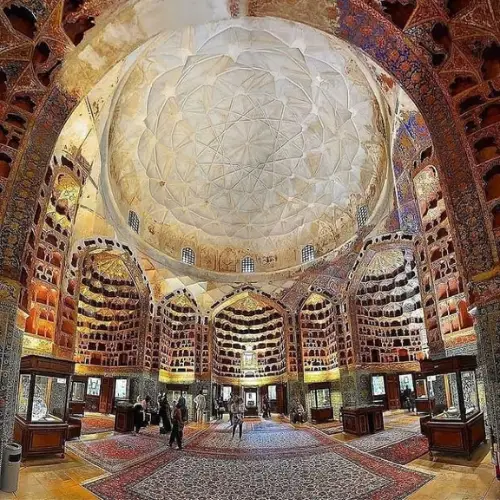
Different parts of Sheikh Safi al-Din Khānegāh and Shrine Ensemble
Undoubtedly, the magnificence and glory of this building cannot be expressed in terms of words, but we have tried to explain some of the parts and places of Sheikh Safi Al-Din Ardabili's Shrine.
Entrance gate
The entrance of Sheikh Safi al-Din Khānegāh and the Shrine Ensemble is located on the eastern front of Ali Qapu Square, which opens to the big courtyard on its two wooden slopes.
This entrance gate with its eye-catching tile work makes all eyes stare at them while they are entering this tomb.
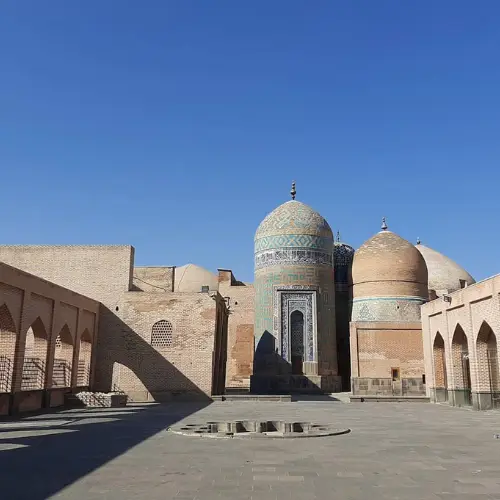
large yard
At the western entrance of Sheikh Safi al-Din Khānegāh and Shrine Ensemble, there is a rectangular courtyard that is, in fact, a gateway between the entrance and the core of the complex. On the two faces, there are two stone ponds, which is probably a relic of the Safavid period.
The brick walls of this courtyard, which are built on the stone floor, have niches and vaults.
Middle corridor or a small courtyard
On the eastern side of the courtyard, a large courtyard with a small doorway, decorated with gypsum and brick, opens to a corridor. This is the era of the Qajar dynasty, which was built instead of the older era of the Safavid period.
The vaults of the sidewalls of the courtyard are covered with beautifully decorated plinths and covered with mosaic tiles. In the southern part of this corridor, a dormitory doorway is located that leads to the New Chelleh Khaneh.
New Chelleh Khaneh (The altar)
This building, which is probably the oldest element of Sheikh Safi Al-Din Ardabili's Shrine, is damaged more than the other parts, and now there is a deserted and square courtyard, and on its western front there are cellars with brick facades and arches.
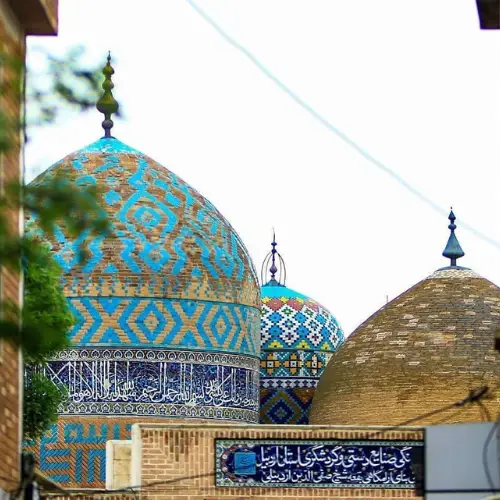
In the northwest of Chelleh House and one of the chambers with its roof, there are remnants of a brick staircase that leads to the upper floor, so the Chelleh House seems to have had the upper floor in the past. Considering the name and composition of this building, it can be considered part of the monastery itself, Sheikh Safi, which has been dedicated to ritual events and the house of dervishes.
The use of the name "altar" for this place is also from the story that this place, after the Safavid period and after its destruction, was shaped like a sacred altar; the use of the new word in this space also means that there is also a former house, which today is a two-floored cellar located on the northwest front of the main courtyard.
Main courtyard or interior courtyard
This courtyard, also known as the Qandil House yard, is a rectangular yard that is covered with smooth stones, and in the center of it is a shallow pond lake with twelve cracks (perhaps representing the twelve Qizilbash sects or the twelve Shia imams). In the past, there was a water well along the pond that provided water, but now it is covered.
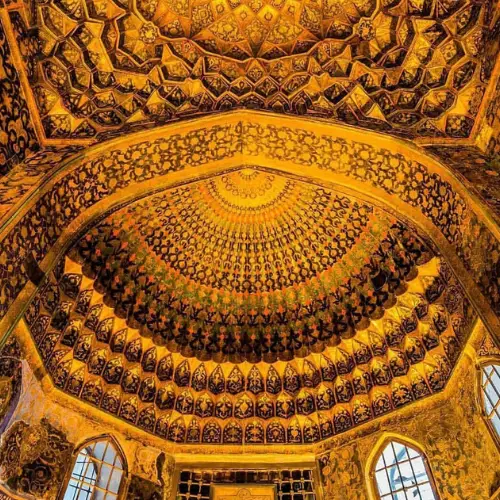
Jannat Sarah
On the northern side of the main courtyard, a porch is located in a large wooden lattice sash. In the north, the porch, which is like a king's mansion, is located in another sash that opens to the dome-shaped and octagonal building called Jannat Sarah.
or On the northern and western walls of Jannat Sarah, there are doors to get to the adjoining rooms. There is no detailed information on the structure of this building and its application. But Olarius, who accurately quoted his observations from this monument in the Safavid period, has not spoken about the Jannat Sarah dome, which like the others in the same period has been called a mosque without a ceiling.
Jannat Sarah seems to have become a library after Shah Abbas donated precious objects and royal library books to Sheikh Safi al-Din Khānegāh and the Shrine Ensemble.
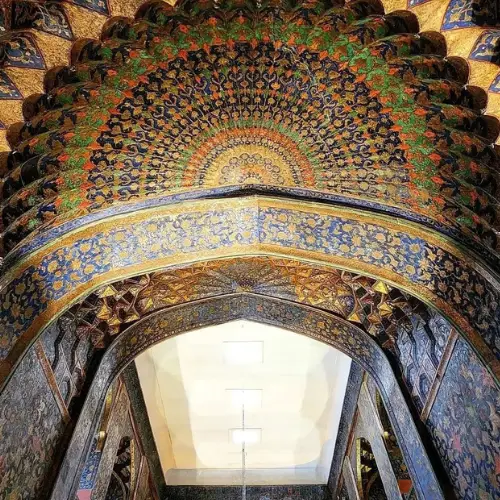
Dome of Allah
It can be said that this dome is the central core of Sheikh Safi al-Din Khānegāh and the Shrine Ensemble, which was made by a person named Sadr al-Din Musa. The word "Jalalullah" is seen on it, which has been repeatedly used, which is why this dome is called the dome of Allah.
From the outside of this dome, you can see a cylindrical brick tower. On a stem and a brick dome, cyan tiles are visible. The verses of the Qur'an are also in line with the third line in the inscription at the junction of the tower and the stem of the dome.
✔️Read More : El Goli |Tranquil Oasis in the Heart of Tabriz
Last Word
The Sheikh Safi al-Din Khānegāh and Shrine Ensemble in Ardebil is a monumental testament to Iran's rich cultural and architectural heritage. This site, a masterpiece of Iranian architecture, is a harmonious blend of various artistic fields, showcasing exquisite mosaic tiles, Mogharnas, plasterwork, calligraphy, and paintings. As a UNESCO World Heritage site, it represents the spiritual and artistic prowess of the Safavid era, especially reflecting the influence of Sufi philosophy in its design and decoration. The complex is not just an architectural marvel but also a repository of history, housing the tomb of the founder of the Safavid Dynasty, Ismail I, and maintaining its sanctity over centuries. Each section of the ensemble, from the majestic entrance gate to the intricately decorated main courtyard and the historic Jannat Sarah, narrates a story of devotion, artistry, and royal patronage. A visit to Sheikh Safi al-Din Khānegāh is an enriching experience, offering a profound insight into the spiritual and artistic legacy of Iran.
FAQ
Questions Related to Visiting the Tomb of Sheikh Safi al-Din:
How accessible is the shrine for international tourists?
Sheikh Safi Al-Din Ardabili's Shrine is easily accessible for international tourists. Ardabil has a local airport, Ardabil Airport, with flights from major cities in Iran. International visitors can fly into Tehran or Tabriz and take a connecting flight or a bus to Ardabil. The shrine is located in the city center, making it accessible by taxi or public transportation from any part of the city.
Are there any recommended hotels near Sheikh Safi Al-Din Ardabili's Shrine?
- shorabil Hotel: Budget-friendly, close to the shrine.
- Saray Hotel: Mid-range, modern amenities, 10-minute drive.
- Yakamoz Hotel: Luxury with spa, 30-minute drive in Sarein.
?What dining options are available near Sheikh Safi Al-Din Ardabili's Shrine
- Ashpazkhaneh Sonnati darbar: raditional Ardabili cuisine
- Shah Abbas Historical Restaurant: Traditional, Historic.
- Shahre Khorshid Fast Food: Coffee and pizza

.webp)
